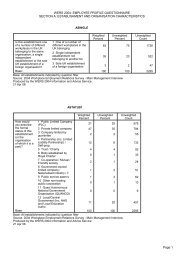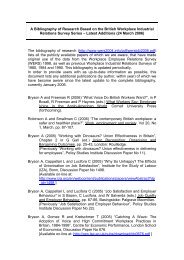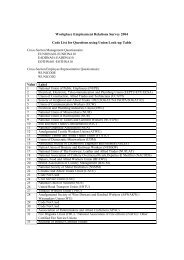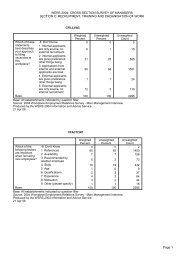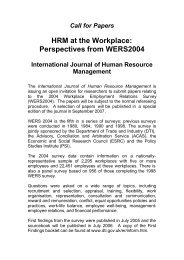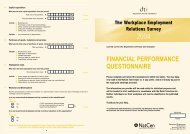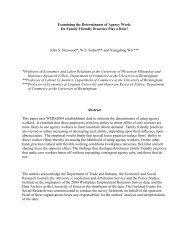A multilevel analysis of job satisfaction in Britain - WERS 2004
A multilevel analysis of job satisfaction in Britain - WERS 2004
A multilevel analysis of job satisfaction in Britain - WERS 2004
Create successful ePaper yourself
Turn your PDF publications into a flip-book with our unique Google optimized e-Paper software.
than men (Clark, 1996, 1997; Clark & Oswald 1996, Blanchflower & Oswald1999; Groot & Br<strong>in</strong>k 1999, Sloane & Williams 2000) but based on a corssnationalstudy Sousa-Poza & Sousa-Poza (2000) f<strong>in</strong>d this to be largely an Anglo-Saxon phenomenon. Higher level <strong>of</strong> education is generally associated with lowerlevel <strong>of</strong> <strong>job</strong> <strong>satisfaction</strong> (Clark 1996, Clark & Oswald 1996, Clark et al. 1996).Blanchflower & Oswald (2001) and Clark (1997) f<strong>in</strong>d some evidence attest<strong>in</strong>g tohigher levels <strong>of</strong> <strong>job</strong> <strong>satisfaction</strong> for married <strong>in</strong>dividuals but Shield & Price (2002)f<strong>in</strong>d no such evidence. There is also some evidence relat<strong>in</strong>g to the effect <strong>of</strong> healthcondition on <strong>job</strong> <strong>satisfaction</strong> where Clark (1996) f<strong>in</strong>ds that health problems leadto lower level <strong>of</strong> <strong>job</strong> <strong>satisfaction</strong>.In terms <strong>of</strong> <strong>job</strong> related characteristics, <strong>in</strong>come is probably the most widely usedcorrelate. Clark (1997) and Shields & Price (2002) f<strong>in</strong>d that <strong>in</strong>come is animportant determ<strong>in</strong>ant <strong>of</strong> both overall <strong>job</strong> <strong>satisfaction</strong> and <strong>satisfaction</strong> with pay.Others, for example Clark and Oswald (1996), f<strong>in</strong>d weak correlation betweenabsolute <strong>in</strong>come and <strong>job</strong> <strong>satisfaction</strong> while Belfield and Harris (2002) f<strong>in</strong>d noevidence that l<strong>in</strong>ks <strong>job</strong> <strong>satisfaction</strong> with absolute <strong>in</strong>come. However, there seemsa consensus on the l<strong>in</strong>k between ‘relative’ <strong>in</strong>come and <strong>job</strong> <strong>satisfaction</strong>. 4 Anumber <strong>of</strong> studies <strong>in</strong>clud<strong>in</strong>g Clark and Oswald (1996), Levy-Garboua &Montmarquette (1997), Neumark & Postlewaite (1998), Sloane & Ward (2001),Hamermesh (2001), and Shield & Price (2002) f<strong>in</strong>d relative <strong>in</strong>come as hav<strong>in</strong>g aneffect on <strong>job</strong> <strong>satisfaction</strong>. Lydon & Chevalier (2002), on the other hand, questionthe validity <strong>of</strong> the notion <strong>of</strong> ‘relative’ <strong>in</strong>come and estimate a <strong>satisfaction</strong> equationthat addresses issues <strong>of</strong> wage endogeneity, f<strong>in</strong>d<strong>in</strong>g a strong effect <strong>of</strong> wages(current as well as future) on <strong>job</strong> <strong>satisfaction</strong>.As well as <strong>in</strong>come and/or wage, hours <strong>of</strong> work has been found to impact <strong>job</strong><strong>satisfaction</strong>. Clark (1996) f<strong>in</strong>ds hours to have a significant negative effect onoverall <strong>job</strong> <strong>satisfaction</strong> and an even stronger negative effect on <strong>satisfaction</strong> withpay. Union membership has, for the most part, been found to have a strongnegative effect on <strong>job</strong> <strong>satisfaction</strong> (Freeman 1978, Borjas 1979, Meng 1990,Miller 199). However, account<strong>in</strong>g for endogeneous selection as well as<strong>in</strong>dividuals and firm level heterogeneity, Bryson et al. (<strong>2004</strong>; 2006) f<strong>in</strong>d nomarked difference <strong>in</strong> <strong>job</strong> <strong>satisfaction</strong> between unionized and non-unionizedworkers.With regards to workplace size the evidence is that larger establishment size isassociated with lower level <strong>of</strong> <strong>satisfaction</strong> (Idson 1990, Clark 1997, Gazioglu &Tansel 2006). Not much evidence exists regard<strong>in</strong>g the relationship between <strong>job</strong><strong>satisfaction</strong> and workplace segregations <strong>of</strong> different sorts. Bender et al. (2005)look <strong>in</strong>to gender segregation and its effect on <strong>job</strong> <strong>satisfaction</strong>. They conclude thatprevious evidence suggest<strong>in</strong>g an <strong>in</strong>crease <strong>in</strong> the level <strong>of</strong> <strong>job</strong> <strong>satisfaction</strong> <strong>of</strong>women as the share <strong>of</strong> women at the workplace <strong>in</strong>creases was due to exclusion <strong>of</strong>important determ<strong>in</strong>ants <strong>of</strong> <strong>job</strong>s <strong>satisfaction</strong> such as flexibility between work andhome. Maume and Sebastian (2007) explore the effect <strong>of</strong> workgroup racialcomposition on the <strong>job</strong> <strong>satisfaction</strong> <strong>of</strong> white workers draw<strong>in</strong>g on a broad 2002cross-section <strong>of</strong> workers <strong>in</strong> the US. 5 They f<strong>in</strong>d that an <strong>in</strong>crease <strong>in</strong> the number <strong>of</strong>4 In Clark and Oswald (1996) ‘relative’ <strong>in</strong>come is taken as the average <strong>in</strong>come level <strong>of</strong> workerswith similar characteristics while Hammermesh (2001) regards ‘relative’ <strong>in</strong>come as surprises thatmake an <strong>in</strong>dividual worker well <strong>of</strong>f.5 The supposition here is that work is fundamentally a ‘social phenomenon’ and that it is at theworkplace, more than <strong>in</strong> other sett<strong>in</strong>gs (such as neighbourhoods, schools, and churches) that5



